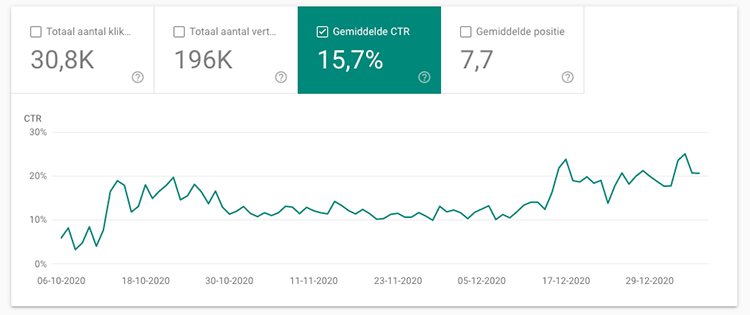Menu
Table of contents
After all, you want your website to get a lot of clicks within organic search results, people to click through from your newsletter, and therefore people to click through on your Google ads.
And the CTR for the latter mentioned is perhaps even more important than within the other online marketing channels. After all, those numbers reflect the effectiveness of your ad.
That effectiveness is related to the ROI of your ads. And so you need to continuously optimize your ads to increase CTR - and get more out of your Google Ads.
And today I'll give you 5 tips on how to do just that.
What is the CTR (click-through rate) and how do you calculate it?
Before we go any further, let me tell you what exactly the click-through rate is. The CTR is the ratio of the number of people who see your ad to the number who actually clicked on it.
A calculation example: your ad is displayed 1,000 times, of which 200 are clicked through, then you have a CTR of 20% (clicks / impressions x100%).

Why is CTR so important?
The CTR is hugely important because it shows how effective your ad is. The higher the CTR, the more people will click through to your website from that ad.
If the CTR is low, then you can assume that the quality and/or relevance of your ad is on the low side. This could mean:
- Your ads are bad (e.g., content is incorrect or not interesting)
- You're reaching the wrong people (in other words, your targeting settings aren't right)
But why the CTR is so important?
Google uses the historical CTR to determine the expected CTR. And the latter, which is an important part of the quality score.
If you've read the blog about quality score, then you know that quality score in turn impacts the price you pay per click. And then the circle is complete again.
Because if you pay less per click, your cost per conversion will be lower. So you'll have more room for even more clicks.
So you see, the CTR of your ads has an almost direct impact on the return on investment of your campaigns. And as a business owner or marketer, that's the most important thing.
Here's what to look for when optimizing your CTR
Before you start optimizing the CTR, you obviously need to know at what level within Google Ads to do so. After all, you can analyze the CTR in several ways:
- Campaign level
- Advertising group level
- Advertising level
- Keyword level
My advice is to look primarily at the keyword level and your ad level. After all, you can optimize and adjust those directly. Is your click-through rate on a keyword low? Then it could be that your ad text does not match the keyword enough.
Then also compare the CTR of your different campaigns to find out what your best performing ads are. After all, you always want to keep those running and replace the poorly performing ads.
5 tips for optimizing CTR
Just as multiple roads lead to Rome, multiple roads lead to a better CTR. And 5 of those paths we will now go through.
Tip #1: Put the keyword in your ad. Make sure it's in title 1 and in the description. In addition, make sure your ad does not look over-optimized. That comes across as fake and Google may reject your ads as a result.
Tip 2: Add as many ad extensions as possible. Ad extensions allow you to grab more space in search results and allow you to share additional information in your ad that is important to your target audience.
Tip 3: Test different ad types. In addition to Extended Text Ads, you can also try Responsive Text Ads. Here you specify up to 15 titles and 4 descriptions. Google's algorithm then automatically creates different combinations that can be unique for each user. This can theoretically increase CTR, but not always! Be sure to keep a close eye on your campaigns if you are going to test this!
Tip 4: Use optimized ad rotation if you're deploying multiple ads per ad group (which I definitely recommend).
With this setting, Google determines which ad is shown per user. Instead of having ads be every other way, use Google's algorithm to determine which ad is displayed per user, which can increase the likelihood of a better CTR.
Note: Again, this is possible but not necessary.
Tip 5: Write catchy ad copy. Perhaps a bit of a lame tip, but I see that ad copy is often written for the search engine and not for the customers themselves.
If your ad doesn't run well and doesn't connect with your target audience, your CTR will be low.
In addition, always include a clear call-to-action and use Cialdini's principles.
Bonus tip: keep testing! When you've created an ad that performs well (and thus has a high CTR), that doesn't mean you can always rely on it. Test new variations, call-to-actions and try a different tone-of-voice.
There is almost always room for improvement!











Written by: Daniel Kuipers
Daniel is the founder of Online Marketing Agency. He constantly scours the Internet for the latest gadgets and tactics and blogs about them in understandable language. Well, sometimes.